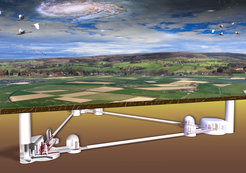The future of gravitational-wave astronomy
Experts discuss the science case for the next generation of earth-based gravitational-wave observatories
On October 1st and 2nd, the Third-Generation Science-Case Consortium Meeting will take place at the Max Planck Institute for Gravitational Physics (Albert Einstein Institute/AEI) in Potsdam. Experts from all over the world will meet to discuss the science case and roadmap for the next generation of gravitational-wave detectors on the ground. They will pave the way for new revolutionary observatories that will be about 10 times more sensitive than the existing instruments, enabling unprecedented and unique science on extreme gravity and matter, cosmology, astrophysics and fundamental physics, unlocking the potential to observe gravitational waves from the earliest moments of the Universe.
The first detections of gravitational waves from black holes and neutron stars heralded the new fields of gravitational-wave astrophysics and multi-messenger astronomy. However, the current (second) generation of observatories are not sensitive enough for precise astronomical studies of gravitational wave sources and the nature of gravity. Now at a conference at the AEI in Potsdam scientists prepare for the next generation of gravitational-wave observatories on the Earth.
“The success of gravitational-wave experiments rests on our ability to develop sophisticated technology and data-analysis algorithms, and to make precise theoretical predictions of the waveforms,” says Prof. Dr. Alessandra Buonanno, one of the meeting’s organizers. “The aim of this workshop is to identify the scientific targets of the third-generation gravitational-wave observatories and discuss what we would need to develop in the next decade to take full advantage of the discovery potential of these ultrasensitive instruments.” This includes conceiving novel methods to predict accurate waveforms of the sources, building fast and efficient data-analysis methods to observe complex signals and infer unique information from them. “With the new generation of instruments, we will learn how black holes and neutron stars form and probe their astrophysical environment. We will understand if dark matter can be made of black holes, and probe the existence of new ultra-light fundamental particles and exotic astrophysical objects, such as boson stars,” explains Buonanno.
Planning for the next generation: Einstein Telescope and Cosmic Explorer

Scientists are making concrete plans for a network of future gravitational-wave observatories. The third-generation detectors will cover the entire range of gravitational-wave frequencies that can be measured on Earth – between about 1 Hz and 10 kHz – and will be able to observe a volume of the Universe about 1000 times larger than that accessible to current observatories. Concepts for the new detector generation are being discussed in both the USA (“Cosmic Explorer”) and Europe (“Einstein Telescope”). European and US third- generation observatories will work together as a network to achieve comprehensive scientific results
The Gravitational Wave International Committee (GWIC), an association of international researchers coordinates the planning for the third generation of gravitational-wave detectors on Earth. Topics currently under discussion are

- The scientific questions to be answered by the third generation of detectors,
- The necessary research and development work,
- The coordination within the community of gravitational-wave researchers, and
- Financing and control/management issues.
These include identifying appropriate technologies, comparing specific technical approaches, clarifying research, time, and funding needs, coordinating and harmonizing global activities in order to cover all necessary research aspects and avoid unnecessary parallel work. A first report on the current situation and the next steps should be available around mid-2019.













